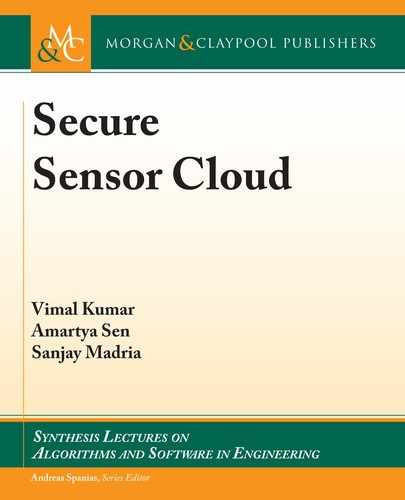94 6. ACCESS CONTROL OF AGGREGATED DATA IN SENSOR CLOUDS
6.9.2 PROTOCOL FOR MODIFYING ACCESS AT RUNTIME
Once the symmetric keys for data aggregation have been established using the session key, the
data collection becomes operational. To modify access to the data, after the data collection is
operational, nodes follow the below protocol.
Nodes SN
1
; : : : ; SN
N
are collecting data and encrypting it securely using keys derived
from partial session keys p
1
; : : : ; p
N
. e authorization level is AL
l
and the aggregate session
key is P . Let’s assume that some event E occurs and in response to E , nodes SN
k
; :::; SN
kCk
0
escalate their authorization level to AL
l
0
; l
0
< l. e nodes SN
k
; : : : ; SN
kCk
0
now generate new
partial session keys p
0
, which will be encrypted with the escalated authorization level key h
l
0
as in Eq. (6.6). is ciphertext is sent to the user along the query tree Q. However, to enable
the user to keep decrypting the data it receives from the rest of the nodes, the sensor nodes
also send their previous partial key p encrypted with the old authorization level. Both the new
and the old partial keys of the nodes N
k
; : : : ; N
kCk
0
which have escalated their authorization
level are aggregated and sent to the user. e user decrypts the old aggregate partial keys
P
p
and generates the new session key as P
P
p. is new session key is then used to derive the
new scrambling, integrity, and perturbation keys for continuing to receive aggregate data from
the rest of the nodes at the old authorization level.
P
p
0
can only be decrypted by the user if
it has the key for the escalated authorization level. us, if the user does not have the required
authorization to decrypt data from a set of nodes it continues to only receive data from the
rest of the nodes. If the user has the private key for the new authorization level, then it can
decrypt
P
p
0
and generate new scrambling, integrity and the perturbation keys. e nodes after
escalating the access level now encrypt their data with the new partial keys. A tag tg is attached
to this encrypted data to indicate the new authorization level. Encrypted data which has the
same tag is aggregated. us, the user now receives two aggregates of data, one encrypted with
keys derived from the new session key and one with keys derived from the old session key. e
user can decrypt one or both the aggregates depending upon the authorization it has.
6.10 SECURITY ANALYSIS
As discussed in the adversary model, the adversary (which is also a malicious user) has the fol-
lowing three goals:
• to try to get access to the data, for which it does not have the secret key;
• to try to access data for which the user does not have authorization; and
• to tamper with the keys and data meant for other users, so as to disrupt the protocol.
To achieve these goals, the adversary can collude with other users and compromise some sensor
nodes. We show in this section that the scheme presented in this chapter prevents the adversary
from accomplishing these goals in the presence of user collusion and node compromise.
..................Content has been hidden....................
You can't read the all page of ebook, please click here login for view all page.
